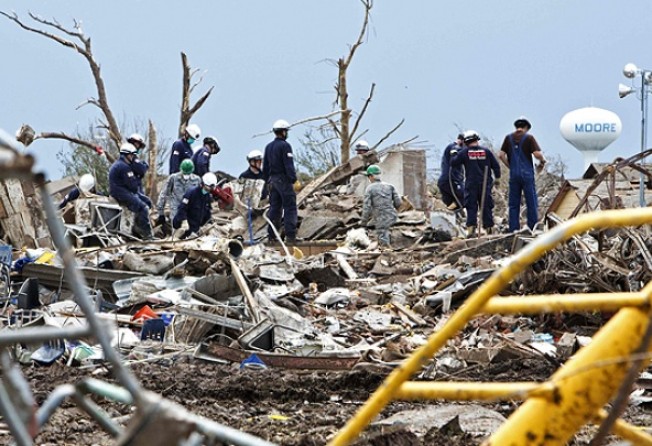Oklahoma tornado ranked in second place on power scale

The tornado that slammed into the Oklahoma City suburb of Moore on Monday was given a preliminary ranking of EF4, the second most powerful category on the Enhanced Fujita Scale.
The Enhanced Fujita scale is an updated version of an earlier chart to measure the ferocity of tornadoes published in 1971 by University of Chicago professor Tetsuya Fujita.
In rating the intensity of tornadoes, meteorologists and other experts study damage on the ground, along with wind speeds and other data, to rate twisters between EF0 (the weakest) and EF5 (the most intense).
The scale is as follows:
- An EF5 tornado, capable of causing incredible damage, is characterised by three-second wind gusts of 320-376km/h and can level strong-framed houses off their foundations, according to the National Oceanic and Atmospheric Administration (NOAA).
Car-sized missiles can fly through the air in excess of 100 metres and trees can be stripped of their bark.
On May 3, 1999, a tornado rated as an F5 under the original Fujita scale also struck Moore, killing 40 people and destroying thousands of homes.
A tornado that struck the town of Joplin, Missouri, on May 22, 2011, was also an EF5.
- An EF4 tornado can cause devastating damage and is capable of levelling well-constructed homes and blowing away those with weak foundations.
Cars can be thrown and large missiles generated. Such a twister includes wind gusts of 270-320km/h.
The tornado that struck Moore on Monday, ripping up at least two schools, has been preliminarily rated an EF4, according to a spokeswoman for the National Weather Service Storm Prediction Centre in Norman, Oklahoma.
- An EF3 tornado can cause severe damage, tearing roofs and walls off well-constructed homes, uprooting trees and lifting cars off the ground and throwing them. It has wind gusts of 220-270km/h. Several EF3 tornadoes have been recorded in the US this year, including one that touched down in Kemper County, Mississippi, in April, killing one person and injuring four.
- An EF2 tornado can cause considerable damage, tearing roofs off frame homes, demolishing mobile homes, overturning boxcars and snapping or uprooting large trees.
Such a tornado is characterised by wind gusts of 177-220km/h. Several EF2 tornadoes have struck the US so far this year, in some cases causing injuries or substantial damage.
- An EF1 tornado can cause moderate damage, with wind gusts of between 138 and 177km/h. Damage caused in such twisters includes surfaces peeled off roofs, mobile homes pushed off foundations or overturned and cars blown off roads.
- An EF0 tornado causes light damage with wind gusts of 104-136 km/h. The impact can include damage to chimneys, branches broken off trees and shallow-rooted trees being knocked over.
TORNADO DEATH TOLL
People killed by the 10 deadliest tornadoes in the US since 1900:
695 deaths. March 18, 1925, in Missouri, Illinois and Indiana.
216 deaths. April 5, 1936, in Tupelo, Mississippi.
203 deaths. April 6, 1936, in Gainesville, Georgia.
181 deaths. April 9, 1947, in Woodward, Oklahoma.
158 deaths. May 22, 2011, in Joplin, Missouri.
143 deaths. April 24, 1908, in Amite, Louisiana, and Purvis, Mississippi.
116 deaths. June 8, 1953, in Flint, Michigan.
114 deaths. May 11, 1953 in Waco, Texas.
114 deaths. May 18, 1902 in Goliad, Texas.
103 deaths. March 23, 1913, in Omaha, Nebraska.
Associated Press